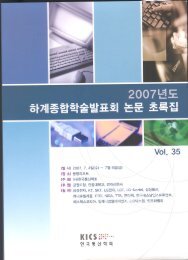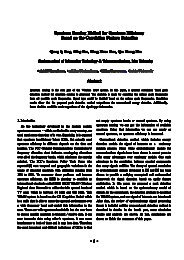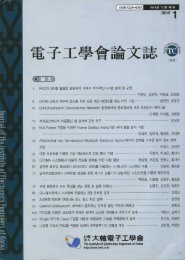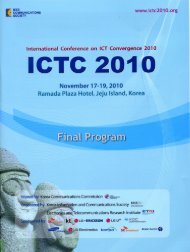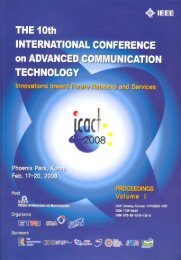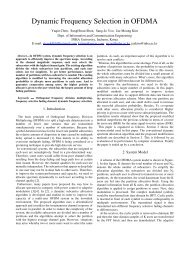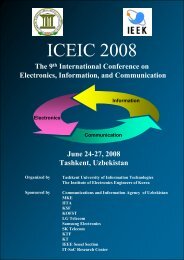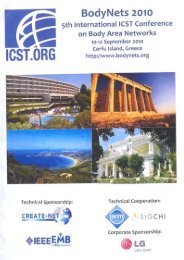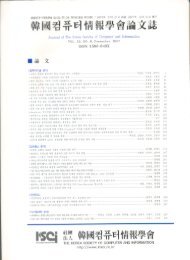Untitled
Untitled
Untitled
Create successful ePaper yourself
Turn your PDF publications into a flip-book with our unique Google optimized e-Paper software.
Frequency Domain Equalization for Doubly Selective Channels<br />
YuQin Chen JongYoung Han Jae Moung Kim<br />
river4416@sina.com, fanaticey@hotmail.com, jaekim@inha.ac.kr<br />
Graduate school of Information Technology & Telecommunications Inha University<br />
Abstract- In this paper, a kind of conventional linear frequency-domain equalizer for doubly selective (time-and<br />
frequency-selective) channels is proposed. We use a basis expansion model (BEM) to approximate the doubly selective channels.<br />
The time-varying impulse response of rapidly fading mobile communication channels is expanded over a basis of complex<br />
exponentials that arise due to Doppler effects encountered with multipath propagation. This model allows us to turn a complicated<br />
equalization problem into a simpler one, containing only the BEM coefficients of the doubly selective channels and the frequency<br />
domain equalizer. Both Zero-Forcing (ZF) and Minimum Mean Square Error (MMSE) equalization are considered.<br />
I. INTRODUCTION<br />
Orthogonal frequency division multiplexing (OFDM) is an<br />
attractive technique for high-speed data transmission in mobile<br />
communications, since it can avoid intersymbol interference (ISI).<br />
The Doppler effect caused by time-variation in conjunction with<br />
ISI give rise to a so-called doubly selective (frequency- and<br />
time-selective) channel. In a doubly selective channel, the channel<br />
variation over an OFDM block destroys the orthogonality between<br />
the subcarriers resulting into so-called inter-carrier interference<br />
(ICI)[1]. In order to mitigate ICI, many techniques, e.g.,<br />
time-domain windowing combined with iterative MMSE<br />
estimation, ICI self-cancellation, have been proposed[2][3]. These<br />
approaches require a high computational complexity or at a price<br />
of sacrificing the spectral efficiency. Moreover, these works<br />
assume perfect knowledge of the TV channel at the receiver,<br />
which is rather difficult if not impossible to obtain.<br />
In this paper, a kind of frequency domain equalization technique<br />
which can compensate for the effects of channel variation in a<br />
multipath fading channel is described by approximating that the<br />
channel impulse response (CIR) is expanded over a basis of<br />
complex exponentials that arise due to Doppler effects<br />
encountered with multipath propagation. This allows us to turn a<br />
large time-variant (TV) problem into an equivalent small<br />
time-invariant (TIV) problem, containing only the BEM<br />
coefficients of the doubly selective fading channel[4].<br />
II.FADING CHANNELS: RANDOM MODLES<br />
In some communication schemes, unpredictable changes in the<br />
medium warrant modeling the TV impulse response (TVIR)<br />
h c(t;τ )as a stochastic process in the time variable t. Since the<br />
components of the multipath signal arise from a large number of<br />
reflections and scattering from rough or granular surfaces, then by<br />
virtue of the central limit theorem, the TVIR can be modeled as a<br />
complex Gaussian process. A simple way to model the fading<br />
channel is wide-sense stationary uncorrelated scattering (WSSUS).<br />
It assumes the channel to be wide sense stationary for a fixed lag<br />
τ and uncorrelated for different lags. The channel spectral density<br />
for a fixed τ is called the scattering function S(ω ;τ );and it<br />
provides a single measure of the average power output of the<br />
channel as a function of the delayτ and the Doppler frequency<br />
ω . The delay-power profile, sometimes also called as multipath<br />
intensity profile, which is defined as the integral ,<br />
∫ ∞<br />
−∞<br />
p ( τ ) = S(<br />
τ , w)<br />
dw<br />
(1)<br />
represents the average received power as function of delay τ ,and<br />
the length of its support is called the multipath spread and is a<br />
measure of the average extent of the multipath. Another function<br />
called Doppler power spectrum<br />
∫ ∞<br />
−∞<br />
S ( w)<br />
= S(<br />
τ , w)<br />
dτ<br />
(2)<br />
is derived from the scattering function and its extent, the Doppler<br />
spread, is a measure of the channel’s time variation[2][5].<br />
s(l)<br />
( )<br />
f tr<br />
c<br />
( l)<br />
sc(t )<br />
(<br />
f ch<br />
c<br />
)<br />
( t;<br />
τ)<br />
vc(t )<br />
rc (l)<br />
f (l)<br />
rec<br />
c<br />
xc (t)<br />
nTs<br />
Fig. 1. Continuous-time TV communication system.<br />
x(n)<br />
Consider the fading communication system model of Fig. 1<br />
before the sampler with the input/output (I/O) relationship<br />
∑ ∞<br />
=<br />
l=<br />
−∞<br />
x c ( t)<br />
s(<br />
l)<br />
hc<br />
( t;<br />
t − lTs<br />
) + vc<br />
( t)<br />
(3)



